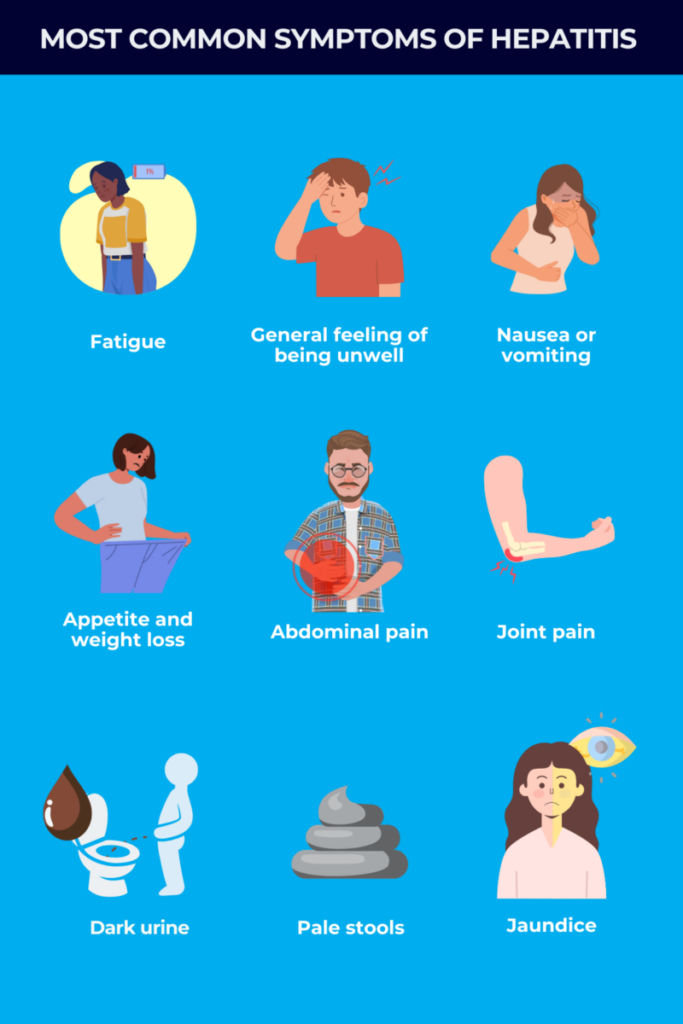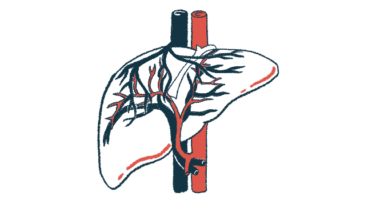Hepatitis symptoms
Last updated Oct. 21, 2024, by Lindsey Shapiro, PhD

Hepatitis — a broad term that refers to liver inflammation — is generally marked by common hepatitis symptoms, such as fatigue, nausea and appetite loss, abdominal discomfort, joint pain, and changes to the color of the skin, eyes, stool, and urine.
The disease is often caused by viruses, as is the case with hepatitis A, B, C, D, and E. However, it can also arise as a result of heavy alcohol use, exposure to toxins, medication reactions, and other medical conditions, including fatty liver disease or cholestasis, and autoimmune diseases like primary biliary cholangitis.
Despite their distinct causes, hepatitis types share many core symptoms. What varies between types is how likely patients are to have symptoms, how soon symptoms appear, and how prone each type is to cause more chronic and serious issues with the liver. There are also differences in the frequency and severity of different types of hepatitis between men and women.
Although early signs of hepatitis may be very subtle, and often resolve on their own, it’s important that patients recognize them and let a doctor know as soon as they occur. This is because hepatitis can go on to cause very serious liver damage if it’s not diagnosed and treated as early as possible.
Main symptoms of hepatitis
In general, hepatitis symptoms are similar regardless of the underlying hepatitis causes, but their severity can vary widely from person to person. The most common symptoms of hepatitis include:
- fatigue
- general feelings of being unwell (malaise)
- nausea and vomiting
- appetite loss
- abdominal pain or discomfort, especially in the upper right side where the liver is located
- joint pain
- dark urine
- pale, gray, or clay-colored stools
- jaundice, a yellowing of the white of the eyes and skin
- fever, especially if the disease is caused by a viral infection.
Hepatitis can be acute, where liver inflammation lasts for less than six months, or chronic, where the inflammation persists longer. Acute hepatitis often does not have any symptoms or the symptoms are relatively mild and short-lived, clearing up before they cause any significant problems.
With chronic forms of hepatitis, symptoms also may not be apparent for years or decades, becoming noticeable only when the chronic inflammation gives way to a damaged liver that no longer works properly.
Differences between types
While there’s much overlap of hepatitis symptoms across types, there are some key differences in the way various forms of hepatitis manifest:
- Hepatitis A: It’s almost always an acute infection, leading to mild, short-term illness that typically resolves within a couple months, if any symptoms are evident at all. Symptoms, more likely in adults than children, usually appear about two to seven weeks after virus exposure. Hepatitis A symptoms are similar to the main signs of hepatitis, with the addition of diarrhea, which may be mild or severe and appears to be specific to this type of hepatitis.
- Hepatitis B: Only about 30% of people with acute hepatitis B will have symptoms and most children under 5 years of age won’t show any signs of the disease. When present, acute hepatitis B symptoms usually develop two to five months after the infection and can last for several weeks. The risk of subsequently developing chronic hepatitis B is higher in people who are infected at a younger age.
- Hepatitis C: Acute hepatitis C typically does not cause noticeable symptoms and most patients will go on to develop a chronic infection. If acute hepatitis C symptoms do occur, they usually appear between two weeks and six months after exposure.
- Hepatitis D: This form only occurs in people already infected with the hepatitis B virus. If the two infections occur at the same time (coinfection), the acute disease may lead to mild to severe hepatitis D symptoms that appear three to seven weeks after exposure, and rarely leads to chronic disease. However, superinfection, where a person with hepatitis B is later infected with the hepatitis D virus, is much more likely to cause severe acute hepatitis symptoms. Also, up to 90% of superinfection cases will progress to chronic hepatitis D, which often progresses more rapidly and has higher rates of complications than chronic hepatitis B alone.
- Hepatitis E: Similar to hepatitis A, hepatitis E almost exclusively causes acute disease that results in either no or mild symptoms that resolve on their own after some weeks. These hepatitis E symptoms usually become evident around two to 10 weeks after infection. The risk of serious disease with hepatitis E is increased in certain people, including those who are pregnant or who have a compromised immune system.
Toxic hepatitis, caused by exposure to toxins, chemicals, or drugs that damage the liver, can cause acute symptoms that come on suddenly and severely after exposure. But it’s also possible that they’ll cause chronic disease, with symptoms showing up weeks or months after exposure.
Autoimmune hepatitis, caused by abnormal immune responses against liver tissue that trigger inflammation, is a form of chronic hepatitis that can develop at any age, but most commonly in early to middle adulthood. Still, patients may develop symptoms only when liver damage is already advanced.
Early signs of hepatitis
In its earliest stages, there may not be any obvious symptoms of hepatitis, so it isn’t always easy to tell that liver inflammation is present. When hepatitis symptoms do emerge, they may be subtle and nonspecific, making a hepatitis diagnosis challenging.
Patients should thus know what are the symptoms of hepatitis that may manifest early on, which may help them detect the disease as early as possible. A few early signs of hepatitis to look out for include:
- feeling unusually tired
- feeling generally unwell
- flu-like symptoms, including a low-grade fever
- abdominal discomfort.
If any of these or other hepatitis symptoms arise, patients should discuss them with a healthcare provider as soon as possible. There are many other nonserious and serious conditions that could cause these same symptoms. A doctor can perform an examination and run tests to help understand whether a person’s symptoms are due to hepatitis.
Even in the absence of any obvious hepatitis symptoms, it’s important to let a healthcare provider know of any potential exposure to a hepatitis virus. In these circumstances, doctors will run tests to confirm whether there is a hepatitis virus infection, and if so, prescribe hepatitis medications or suggest vaccination, which is available for some viral hepatitis types, to stop the infection from developing or getting worse.
Symptom progression and complications
In the first stages of hepatitis, inflammation in the liver may be mild and cause no or subtle symptoms. However, left untreated, this inflammation can promote tissue scarring, or fibrosis, that can progress to damage the liver and interfere with its ability to work normally.
When the liver is scarred and damaged irreversibly, this is known as cirrhosis or hepatic cirrhosis and is the stage where a person with chronic hepatitis is most likely to have significant symptoms.
When the liver is not functioning right, substances that the organ normally produces and toxins and waste products that it processes for elimination start to accumulate in the bloodstream. That includes bile acids, a component of bile that’s made in the liver and sent to the intestines to help with digestion, and bilirubin, a yellowish-red waste product normally processed in the liver for excretion through the intestines.
Hepatic cirrhosis symptoms that may be noticeable at this point include:
- jaundice, where the skin and whites of the eyes look yellow due to bilirubin accumulating in the blood
- dark urine and light-colored stool, due to excess bilirubin excretion in the urine and less than usual in the stool
- itchy skin, or pruritus, which is thought to be associated with bile acid buildup in the bloodstream
- hepatic encephalopathy, a collection of neurological symptoms such as confusion, disorientation, or drowsiness, that can occur when toxins reach the brain.
Severe and persistent liver inflammation can eventually cause serious complications of hepatitis beyond cirrhosis, including:
- Portal hypertension, or high blood pressure in the vein that transports blood from the gastrointestinal system to the liver. The vessels may become compressed by the accumulating scar tissue in the liver and expand, which increases the risk for life-threatening ruptures and internal bleeding.
- Hepatocellular carcinoma, the most common type of liver cancer. Both hepatitis and cirrhosis are risk factors for this type of cancer, and hepatitis B and C are particularly associated with the development of cancerous liver lesions.
- Liver failure, where the liver can no longer perform its necessary functions. Liver failure can be acute, coming on suddenly due to factors like medication toxicity, or chronic, as a result of years of accumulating liver damage. Both are life-threatening, but acute liver failure can sometimes be reversed while chronic cannot.
- Problems outside the liver, including the kidneys, joints, skin, and cardiovascular and immune systems, which can be caused by hepatitis viruses, particularly hepatitis B and C.
While the progression of hepatitis to cirrhosis and other life-threatening complications can take many years, it’s also possible, although unlikely, for acute hepatitis to progress rapidly and cause serious problems over a very short time. This is known as fulminant hepatitis, which can progress to liver failure within days or weeks. Fulminant hepatitis is most likely to occur in people with hepatitis B and D virus coinfection, drug-induced hepatitis, or with a history of heavy alcohol use.
Signs of advanced liver disease
In the most advanced stages of liver disease, when the organ is not able to perform its normal functions, survival may depend on the elimination of the underlying hepatitis cause or on a liver transplant.
In addition to hepatic cirrhosis symptoms like jaundice, pruritus, changes in the color of urine or stool, and hepatic encephalopathy, signs of liver failure may include:
- significant weight loss and digestive problems
- easy bleeding and bruising
- small, spider-like blood vessels visible beneath the skin’s surface, known as spider angiomas or spider veins
- xanthomas, or raised skin lesions that appear waxy and yellowish, that consist of deposits of the fatty molecule cholesterol underneath the skin
- musty-smelling breath.
Other serious symptoms that could be indicative of acute or chronic liver failure include:
- blood in stool or vomit caused by the rupture of enlarged veins in the gastrointestinal tract associated with portal hypertension
- fluid buildup in the abdomen and/or swelling in the legs, ankles, and feet also due to portal hypertension
- reduced urine output
- shortness of breath
- motor problems, such as twitching, tremors, or loss of muscle control.
These symptoms should be considered a medical emergency, especially if they come on suddenly. Patients who experience them should immediately seek medical attention.
Sex differences
In general, hepatitis symptoms in men are similar to hepatitis symptoms in women, but there are some sex differences in the risk of developing certain types of hepatitis and how quickly and severely they progress.
In general, hepatitis tends to affect men more frequently than women and women seem to have better responses to treatment and a reduced risk of complications.
For example, acute hepatitis A infections are seen more often in men, and women appear to respond better to vaccines against the virus. Men are also more likely than women to develop chronic hepatitis B and C infections and associated serious liver complications, including cirrhosis, liver cancer, liver failure, and death.
Among those with hepatitis C, men also seem to develop serious liver damage on average a decade earlier than women, who are more likely to spontaneously clear out the virus and have a good response to antiviral therapies.
In turn, autoimmune hepatitis affects women substantially more than men. Still, men tend to present symptoms at a younger age, are more likely to already have cirrhosis at the time they’re diagnosed, and are at higher risk of worse liver-related complications.
Liver Disease News is strictly a news and information website about the disease. It does not provide medical advice, diagnosis or treatment. This content is not intended to be a substitute for professional medical advice, diagnosis, or treatment. Always seek the advice of your physician or other qualified health provider with any questions you may have regarding a medical condition. Never disregard professional medical advice or delay in seeking it because of something you have read on this website.
Recent Posts
- Less invasive Kasai surgery works better for infants with BA: Study
- US states, doctors split with CDC on hepatitis B shots for newborns
- PSC-IBD study shows need for regional management guidelines
- Staying on top of MASH may mean not staying on the transplant list
- Common virus may play a role in ICP development, study finds
Related articles






